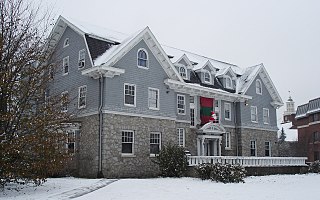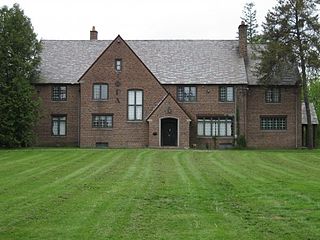
Alpha Gamma Delta (ΑΓΔ), also known as Alpha Gam, is an international women's fraternity and social organization. It was founded on May 30, 1904, by eleven female students at Syracuse University in Syracuse, New York, making it the youngest member of the Syracuse Triad of North American social sororities, along with Gamma Phi Beta and Alpha Phi. Since then, Alpha Gamma Delta has, as of December 2021 initiated over 201,000 members and has 199 installed collegiate chapters and more than 250 alumnae groups.

North American fraternity and sorority housing refers largely to the houses or housing areas in which fraternity and sorority members live and work together. In addition to serving as housing, fraternity and sorority housing may also serve to host social gatherings, meetings, and functions that benefit the community.

Alpha Chi Alpha (ΑΧΑ) is a fraternity at the American Ivy League university of Dartmouth College. Alpha Chi Alpha is a member of Dartmouth's Greek system, which currently has fourteen fraternities, nine sororities and three co-ed undergraduate houses that fall under the umbrella of the Greek system.

Dartmouth College is host to many Greek organizations, and a significant percentage of the undergraduate student body is active in Greek life. In 2005, the school stated that 1,785 students were members of a fraternity, sorority, or coeducational Greek house, comprising about 43 percent of all students, or about 60 percent of the eligible student body. Greek organizations at Dartmouth provide both social and residential opportunities for students, and are the only single-sex residential option on campus. Greek organizations at Dartmouth do not provide dining options, as regular meals service has been banned in Greek houses since 1909.

Gamma Phi Beta is an international college sorority. It was founded in Syracuse University in 1874, and was the first of the Greek organizations to call itself a sorority. The term "sorority" was coined for Gamma Phi Beta by Dr. Frank Smalley, a professor at Syracuse University.

Franklin College is a private liberal arts college in Franklin, Indiana. It was founded in 1834 and has a wooded campus spanning 207 acres including athletic fields and a 31-acre biology woodland. The college offers its approximately 1,000 students Bachelor of Arts degrees in 49 majors from 25 academic disciplines, 43 minors, 11 pre-professional programs and five cooperative programs. The college also offers a Master of Science in Athletic Training and a Master of Science in Physician Assistant Studies. In 1842, the college began admitting women, becoming the first coeducational institution in Indiana and the seventh in the nation. Franklin College has historically maintained an affiliation with the American Baptist Churches USA.

Delta Theta Sigma (ΔΘΣ) is a social professional agricultural fraternity. It was created in 1906 at The Ohio State University. There are currently seven active chapters of Delta Theta Sigma.

Llenroc is a Gothic revival villa built for Ezra Cornell, the founder of Cornell University. It is located at 100 Cornell Avenue in Ithaca, New York, United States, just below the Cornell University campus. Since 1911, it has been the home of the Pi Chapter of the Delta Phi fraternity.
The College of William & Mary fraternity and sorority system recognizes chapters of national organizations belonging to the Panhellenic Council, the Interfraternity Council (IFC) and the National Pan-Hellenic Council, and also recognizes one local fraternity without Greek letters and the local chapter of one national fraternity that abandoned membership in an inter-Greek consortium. The school also offers a variety of honor and co-ed service fraternities as well. The first collegiate fraternity within the present borders of the United States, the Latin-letter F.H.C. Society, was founded at the College of William & Mary on November 11, 1750. The new country's first Greek-letter fraternity was founded at the College on December 5, 1776, though the Phi Beta Kappa Society no longer is a social fraternity but, instead, the leading American academic honor society. Some fraternities and sororities are limited to graduate students at William & Mary, while others may only be joined at the undergraduate level. Still other Greek-letter organizations operate without recognition or approval from college administrators.

The Delta Psi, Alpha Chapter fraternity house is located at 434 Riverside Drive in the Morningside Heights neighborhood of Manhattan, New York City. It was purpose built in 1898 and continues to serve the Columbia Chapter of the Fraternity of Delta Psi, a social and literary fraternity.

The Chi Omega Chapter House is a building built in 1927 on the campus of the University of Arkansas in Fayetteville, Arkansas. The building was listed on the National Register of Historic Places in 1995.

St. Anthony Hall House is a historic fraternity house located in the University City neighborhood of Philadelphia, Pennsylvania. It is the Delta chapter house for the social and literary Fraternity of Delta Psi for the University of Pennsylvania. It was added to the National Register of Historic Places in 2005.

Fraternities and sororities at the University of Virginia include the collegiate organizations on the grounds of the University of Virginia in Charlottesville, Virginia. First founded in the 1850s with the establishment of a number of fraternities, the system has since expanded to include sororities, professional organizations, service fraternities, honor fraternities, and cultural organizations. Fraternities and sororities have been significant to the history of the University of Virginia, including the founding of two national fraternities Kappa Sigma (ΚΣ) and Pi Kappa Alpha (ΠΚΑ).

The Delta Kappa Epsilon Fraternity House was a historic fraternity house located at the University of Illinois at Urbana–Champaign in Champaign, Illinois.

Phi Gamma Delta House is an historic fraternity house at 79 College Avenue, near the campus of the University of Maine in Orono. It is the only Tudor Revival fraternity house on that campus, and was built to provide increased housing to the school's male student population. The architects were Crowell & Lancaster. It was listed on the National Register of Historic Places in 2013.

The Sigma Alpha Epsilon Fraternity House is a historic fraternity house in Moscow, Idaho. It was built in 1932 for the Idaho Alpha chapter of Sigma Alpha Epsilon at the University of Idaho. The house was designed by architect Charles I. Carpenter in the Colonial Revival style. It has been listed on the National Register of Historic Places since December 31, 1993.

Alpha House is a fraternity house located at 293 Eliot Street in Detroit, Michigan. It is significant as the longtime headquarters of the Gamma Lambda Chapter of Alpha Phi Alpha fraternity. The house was listed on the National Register of Historic Places on August 26, 2021.




















